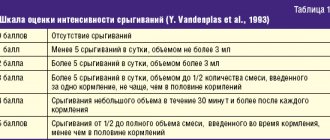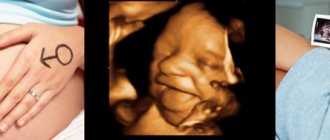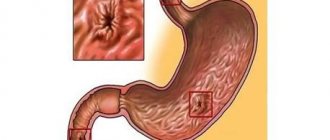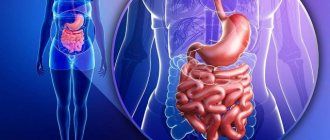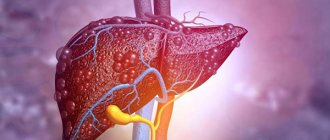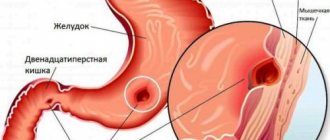Each person's body is unique.
Some people easily tolerate colds and even flu on their feet, practically without giving up their usual daily routine, while other people, even with a slight increase in body temperature, need strict adherence to bed rest. Of course, the most difficult time during illnesses is for children whose immunity is not yet fully developed and is not able to act as a reliable shield against infections. As a result, even ordinary ARVI in children often occurs with complications, which include abdominal syndrome - one of the most common reasons for visiting a doctor and one of the main reasons for emergency hospitalization. Parents need to remember that if their child has abdominal pain due to colds and flu, they should not give painkillers; they need to understand the situation and begin treatment with the help of a doctor.
- Causes and symptoms of abdominal syndrome with enteroviral infections
- For adenoviral infections
- For cytomegalovirus infections
- For hemorrhagic fever
Abdominal (translated from Latin abdomino - belly) is a term that refers to organs related to the abdomen. Consequently, the organs of the gastrointestinal tract and genitourinary system are abdominal organs, and doctors call diseases of these organs abdominal diseases.
Abdominal syndrome in children is a collection of symptoms that accompany various conditions. Most often, this syndrome is manifested by convulsive contractions of the muscles of the internal organs, bloating of the intestines and inflammation of the peritoneum, which leads to painful sensations.i
The origin of clinical symptoms in the abdominal cavity is highly variable. Therefore, making a correct diagnosis in the presence of abdominal pain is not an easy task for any pediatrician. The fact is that the diagnosis of “viral infection with abdominal syndrome” can only be used at the first stage of medical care. It is imprecise, vague and needs further verification. Sometimes it turns out that the child is worried about something completely different from the disease that the doctor initially thought about. After all, the range of pathogens that lead to abdominal pain is very wide and includes not only viruses.
Delay in starting treatment in the presence of abdominal pain in many cases can lead to the development of serious complications in the child. In surgical practice, the concept of “acute abdomen” is still used, which is a clinical symptom complex that develops in acute diseases of the abdominal cavity and retroperitoneal space. “Acute abdomen” in children refers to an urgent pathology - a condition that requires urgent intervention by a doctor, often a pediatric surgeon. Therefore, if a child experiences abdominal pain, it is necessary not to self-medicate, but to immediately seek help from a specialist.
ARVI with abdominal syndrome: causes and symptoms
The causes of the development of abdominal syndrome, which appears against the background of the presence of signs of inflammation of the upper respiratory tract, can be different conditions. Each specific case requires the most careful diagnostic measures.ii
Among the most common symptoms of abdominal syndrome are paroxysmal abdominal pain similar to intestinal colic, muscle tension in the anterior abdominal wall, nausea, vomiting, bloating, loose stools, and increased body temperature.
Most often, the appearance of discomfort in the abdominal area against the background of cold and flu symptoms is associated with enterovirus, adenovirus and cytomegalovirus infections, including mononucleosis-like syndrome, and hemorrhagic fever.
Enteroviral infections
Enterovirus infections belong to a large group of diseases that occur in people of all ages, but most often in young children and newborns.iii The list of the most common enteroviruses includes polioviruses, Coxsackie viruses of groups A and B, echoviruses (ECHO) and unclassified enteroviruses of various serotypes. The main mechanisms of infection transmission are fecal-oral and airborne.
The catarrhal form of enterovirus infection in children occurs as an acute respiratory viral infection. The child may be bothered by nasal discharge, coughing, sneezing, or elevated body temperature. There is also hyperemia of the mucous membranes of the nasopharynx, and the development of false croup is possible. In the gastroenteric form of the disease, dyspeptic syndrome is added to the usual symptoms of ARVI, which makes itself felt by increased gas formation in the gastrointestinal tract, diarrhea and vomiting.
Adenoviral infections
Adenoviral infection is also included in the broad group of acute respiratory viral infections. In the general structure of respiratory tract diseases, it makes up more than 20% and most often occurs in children from six months to three years. In addition to direct transmission of the virus from person to person, children can be infected through water, which is why this disease is also often called “pool disease.”
The development of the disease always begins rapidly - the child is bothered by abdominal symptoms: nausea, vomiting, flatulence. Body temperature can rise to 39 0C or more, watery stools appear, which are accompanied by paroxysmal abdominal pain. The clinical picture of the disease may resemble acute appendicitis. When the virus affects the respiratory tract, nasal breathing becomes difficult, the voice becomes hoarse, and the submandibular and cervical lymph nodes enlarge.
Cytomegalovirus infection
During acute cytomegalovirus infection, almost all types of cells in the human body can be affected, which explains the variety of clinical forms of diseases caused by the CMV virus. This infection leads to depression of almost all parts of the immune system and has the ability to sharply inhibit the production of interferons - proteins with similar properties that are secreted by the body's cells in response to the invasion of viruses and bacteria. CMV is most often transmitted by airborne droplets, and it can also be transmitted during pregnancy from mother to fetus.
The most common manifestation of the acute form of this disease is mononucleosis-like syndrome. Symptoms of intoxication during cytomegalovirus infection are initially mild and are expressed in the form of low-grade body temperature. Further, the fever increases, a sore throat may appear, hyperemia of the pharyngeal mucosa and enlargement of regional lymph nodes are observed. If the liver is damaged, the child may be bothered by abdominal manifestations: abdominal pain, nausea and vomiting.
Hemorrhagic fever
This disease is part of a group of infectious diseases that cause toxic damage to the vascular walls and thereby contribute to the development of hemorrhagic syndrome - a pathology of the hematopoietic system, which is accompanied by the formation of red spots on the skin and an increased tendency to bleed. Viruses that cause fever lead to a wide variety of symptoms similar to acute respiratory infections, including fever, sore throat, chest and back pain, cough, conjunctivitis, vomiting, diarrhea, and skin rash.
The source of the virus is humans, and mosquitoes and ticks can act as carriers. Without adequate treatment, hemorrhagic fever can lead to the development of severe and life-threatening conditions, including acute renal failure and toxic shock.
WHAT IS THE DANGEROUS OF WRAPING A CHILD?
The question of how to properly dress a child is often discussed by parents and pediatricians due to the fact that a child's thermoregulation is traditionally considered immature. The younger the child, the less perfect his thermoregulation is called. This thesis inevitably gives rise to the desire to dress the child warmer in order to “compensate” for this immaturity. Is this correct and will wrapping help the maturation of thermoregulation mechanisms?
What is thermoregulation?
Thermoregulation is the ability of humans, mammals and birds to maintain the temperature of the brain and internal organs within narrow certain limits, despite significant fluctuations in the temperature of the external environment and their own heat production.
The normal functioning of thermoregulation can be influenced by many factors.
For example, when overwrapping, that is, when there is a threat of overheating of the body, skin vessels dilate, sweating and heat transfer increase. When there is a threat of cooling, the skin vessels narrow, the hair rises and heat transfer is limited, and heat production increases.
Thus, the body maintains a balance between heat production and heat loss in different temperature situations.
Features of children
The surface area of a child's skin relative to his weight is much larger than that of adults. So, in newborns there is 700 cm 2 of skin per 1 kg of body weight, in ten-year-old children - 425 cm 2, and in adults - 220 cm 2. This means that the younger the child, the more intense heat transfer occurs.
In this case, in children:
- There is no cold shivering;
- There is a relatively high skin temperature in the thermoneutral zone and a relatively small amount of sweat produced.
- Thermoregulation is carried out mainly through the production of internal heat, while thermoregulation, through the constriction and dilation of blood vessels, develops later.
The maturation of the central hypothalamic mechanisms of thermoregulation in children can be judged by the establishment of the correct daily rhythm of body temperature, which occurs by 1.5–2 months of age.
By observing the child, you can see how he tolerates hardening procedures. The absence of tremor and blueness of the skin indicates good thermoregulation of the baby.
Any system must be “started”
In the neonatal period, stimulation of skin receptors is necessary for the functioning of the thermoregulation system, and nothing special needs to be done for this. It is enough to simply keep the child in natural conditions. Continuous swaddling and the creation of conditions with a constant temperature lead to the fact that this system not only does not start, but also atrophies. Wrapping up a child during waking hours and thermostatically keeping him (constant thermal comfort) lead to coagulation due to the uselessness of thermoregulation mechanisms and frequent colds (acute respiratory infections, acute respiratory viral infections). This is what gives rise to up to 80-90% of all child diseases.
When a person is taught from childhood to cold as a norm and not a danger, his body reacts harmoniously to low temperatures. When cooling, blood flows to the organs, carefully “warming” them, and the protective forces are activated. On the street, the skin becomes cold - this is when the blood drains away to save the internal organs. But if it is very cold, and the person does not move, the blood “freezes” and the body becomes vulnerable. . If a person has been accustomed from birth to temperature changes, when cooled, the blood will remain, roughly speaking, where it was, keeping the arms, legs and face warm, and will not panic and run away to save other organs, obeying nervous tension.
Individual characteristics
Allergy to cold
Cold in itself is not an allergen, because an allergy is a reaction to a foreign protein. When going out into the cold, your own proteins form a structure that the body’s defense system mistakes for someone else’s – as if an allergen has invaded. Also, an allergy to cold can manifest itself in the form of ongoing chronic tonsillitis (inflammation of the tonsils). If you have skin rashes (due to an allergy to cold), you need to moisturize your skin at home after bathing, and do not use soap (it is better to use special cosmetics for dry skin). Use a nourishing, rich cream when going outside, lubricating not only your face, but also your hands.
On the street, the child must be completely “packed”: the overalls cover the throat, adjustable valves on the sleeves and legs, and waterproof mittens that prevent the hands from getting wet and getting cold.
Prematurity
The amount of heat necessary to maintain body temperature is produced in a full-term baby immediately after birth.
With a significant degree of prematurity, when newborns have varying degrees of hypothyroidism, and the mass of brown adipose tissue is less than 1% of body weight, heat production is reduced. This can contribute to the development of hypothermia if conditions are not created to limit heat loss.
Diseases
The contribution of contractile thermogenesis to heat production can change in a number of neurological and muscular diseases, as well as in the development of hypoxia caused by diseases of the circulatory and respiratory organs.
Hypoxia, intracranial trauma, infections affecting the central nervous system (CNS), as well as its anomalies, can cause dysfunction of the central thermoregulatory apparatus.
Immunological deficiency
When the air temperature is below -15, phagocytosis decreases, that is, the body's cells do not suppress various bacteria and viruses. If a child was immunocompromised before hypothermia, then after it he will get sick and will further reduce the adaptive capabilities of the immune system. At other times, the body would repel the attack, but after frost, immunity drops significantly in a short time.
So how to dress a child?
In its anatomical and physiological characteristics, a child’s body differs significantly from an adult’s body. It is unacceptable to compare your feelings with the feelings of a child: adult immunity is often impaired by factors that directly affect frost resistance. Both cooling and overheating are equally harmful to a child’s health.
The accumulation of excess heat leads to sweating - even if the child feels dry to the touch, this does not mean that his body has stopped evaporating moisture. Covered children on the street sweat, cool down, sweat again, cool down again, this process leads to a decrease in immunity and various diseases. In addition, sweat moistens clothing, reducing its heat-protective properties. Therefore, it is necessary to take into account all possible individual characteristics of the child, as well as temporary situational factors that will determine the choice of the optimal way to dress the child
Tips for parents:
- When going out, always dress yourself first, and then dress your child.
- It is very useful to pour cold water on your hands and feet 4-5 times a day. Blood flows to the internal organs, adding new portions of oxygen and nutrients to the cells. Cold baths help increase the amount of hemoglobin, red blood cells and white blood cells. Immunity increases accordingly.
- To protect yourself from colds, there is an effective preventive trick: try giving your child a few sips of water at room temperature 15-20 minutes before going out into the cold air. During this time, the body will prepare for the upcoming temperature jump - after all, our throat is +37°, and water at room temperature is approximately +20°. And drink it yourself too.
- When going out to the store, use separate overalls (set) so that the child can take off the jacket. Take off your hat and scarf. The sight of children in stores dressed in overalls, hats and hoods evokes sympathy.
- Remember that it is not layers of clothing that keep you warm, but the right clothing. It is not the insulation that warms, but the cavities between the fibers of the insulation (which is why many winter overalls are very light). For children, they produce quite high-tech overalls, in the manufacture of which modern materials are used, which allow, on the one hand, not to freeze, and on the other, to feel comfortable in these clothes. For example, fleece is artificial wool; its characteristics are equal to it, but its weight is much lighter. A wool hat can be replaced with a double fleece hat. Fur hats have been replaced by hats with synthetic insulation (Isosoft, Thinsulate) and woolen helmets, which make it possible not to use a scarf. Some helmets are additionally insulated. A thin woolen helmet can be worn without a hood up to a temperature of -10, excluding days with a piercing wind.
- To help freezing hands, manufacturers produce waterproof mittens, which are similar to sports mittens. The mittens have an extended cuff with Velcro or a zipper. The cuff is pulled over the sleeve - or hidden under it. These mittens are insulated with sheepskin, Thinsulate or other filling. It is important that the waterproofs are soft, not “oaky”, otherwise the child will simply refuse to wear them.
- In excessively thick clothing, a child may sweat and quickly become hypothermic. It is harmful to wrap your baby's head and neck too warmly. The neck contains large blood vessels - arteries and veins. Due to excess heat, they expand, more blood flows to the neck and head, but this rush occurs due to its outflow from the legs, arms and internal organs. Overheating one part of the body and cooling others is extremely harmful. Children who constantly have their necks wrapped excessively in warm scarves are more likely to get sore throats and the flu.
- Know that the child breathes normally in any cold. If he closes his mouth, the air will become moist, which leads to colds. Before you go out, clean your child’s nose – and everything will be fine.
- Legs and arms are the first to suffer during winter walks. The muscle mass, which helps conserve heat, is insignificant in these parts of the body. There is no subcutaneous adipose tissue, but there is a large surface area of the skin that gives off heat. Legs and arms should not normally be warm, only cool (slightly below room temperature), this means normal thermoregulation.
- You can determine whether a child is cold by looking at the bridge of the nose, neck and skin above the feet and hands.
Rosy cheeks and nose are a sign of health and a great time, not freezing. The blood must flow to the face so that it does not freeze.
We look at the thermometer and get dressed:
+5/-5 Long-sleeved T-shirt, membrane overalls or padding polyester, winter shoes with tights, wool mittens or gloves, a hat made of wool or mixed with acrylic.
-5/-10 Underwear (for a membrane - with synthetics) or thermal underwear, a thin turtleneck, overalls filled with polyester (isosoft, holofiber, etc.) or membrane, winter shoes with tights (if the shoes are membrane, the tights should be mixed) , woolen hat, woolen mittens or leggings.
-10/-15 Underwear or thermal underwear, suit made of fleece or wool, overalls filled with polyester or down. We put on a hood in case of strong wind. Waterproof mittens or woolen ones with fur. Winter shoes - felt boots with a wool sock or winter boots with a wool toe or thermal sock.
-15/-25 Everything is the same as in the previous paragraph, walks are limited in time: no more than an hour in calm weather, no more than half an hour in windy weather. If you like to walk in the cold, be sure to buy your child a full set of thermal underwear, including socks and mittens, then the duration of walks can be slightly increased.
Why is wrapping dangerous?
- Decreased immunological resistance. Children who are wrapped up are often sick children in the future.
- Immaturity of thermoregulation mechanisms. Overwrapped children are children with disadaptation syndrome.
- Impaired skin sensitivity.
- Skin diseases.
- Underdevelopment of areas of the brain that need stimulation through skin areas.
- Delay in psycho-motor development.
- Disturbances in the formation of the musculoskeletal system.
- Vegetative-vascular dystonia.
Enough? Then, in conclusion, a few words about how you can help the maturation of thermoregulation .
A properly selected hardening system by a doctor, taking into account all possible individual characteristics of the child, contributes to the formation of healthy thermoregulation.
Water hardening is the most effective, but who should be hardened and in what way should be decided together with a doctor.
Timely, competent solution to problems leading to a lag in the formation of thermoregulation will stimulate its development.
AND... DON'T TURN YOUR CHILD !
Smirnova E.G. Immunologist, Center for Natural Development and Child Health
You can make an appointment or call a pediatrician at home by calling the Center in Moscow:
+7(495) 229-44-10, +7(495) 954-00-46
Previous
Next
Complications after ARVI in children
Complications after acute respiratory viral infections in children are directly related to the type of viruses that affected the body. The addition of a bacterial infection often leads to bronchitis, the lungs are also affected, and pneumonia may develop. According to statistics, with enterovirus infections, bacteremia complicates the course of ARVI in almost 7% of cases.
Young children are at risk of developing acute otitis, including purulent otitis, which requires antibiotic therapy. If a child’s nose is stuffy for more than two weeks, and there is a worsening of the condition after the first week and pain in the face, this may indicate the development of bacterial sinusitis.
ARI can also become a trigger for exacerbation of existing chronic diseases in a child, most often bronchial asthma and urinary tract diseases.
Complications of ARVI in children: can they be avoided?
It is not only impossible to protect children from ARVI, but in the opinion of many pediatricians, it is not necessary. According to experts in the field of child health, acute respiratory viral infections form the child’s immunity and “train” his immunity to identical and more severe viral infections that may occur in the future.
In case of ARVI with abdominal syndrome in children, you must immediately consult a doctor who will prescribe diagnostic measures and, depending on the identified cause of the disease, recommend treatment.
Treatment for ARVI should be started at the first symptoms of the disease and include methods to reduce intoxication of the body (for example, you must remember to give the child clean, warm water without sugar more often), as well as taking medications and carrying out symptomatic treatment. When fighting viruses, it is better not to try to fight the disease only by drinking plenty of fluids and rest, but to immediately give the child an antiviral drug.
One of the antiviral drugs approved for the treatment of children from the first days of life is the drug VIFERON, which has a wide spectrum of antiviral activity. Antiviral properties allow it to block the reproduction of the virus, and the immunomodulatory effect helps restore immunity. The drug, which is produced in the form of suppositories, gel and ointment, was developed as a result of fundamental research in the field of immunology, which proved that in the presence of antioxidants (vitamins C, E), the antiviral effect of interferon is enhanced.
The drug VIFERON Suppositories can be used to treat very young children, including newborns and premature babies with a gestational age of less than 34 weeks.
VIFERON Gel can be used for the treatment and prevention of ARVI and influenza, starting from the first days of a child’s life. VIFERON Ointment is used to treat children from 1 year of age.
What should parents do if their child has vomiting, diarrhea and fever?
Since such symptoms (vomiting, diarrhea, nausea with fever) are characteristic of many childhood diseases and pathologies, the most correct thing for parents in acute situations and at high temperatures would be to urgently call a doctor at home.
A doctor's consultation is required if:
- vomiting and diarrhea in a child, even without fever, continues for several days;
- the child has a temperature of 38, vomiting and diarrhea;
- the child has a high temperature and a stomach ache;
- the child tries to constantly lie down, reactions to external stimuli are impaired;
- The child's stool is abnormally colored.
If the symptoms do not cause concern to parents, then at least consulting assistance from a pediatrician, pediatric gastroenterologist or other pediatric specialists is still desirable.
But even before the doctor arrives, parents can independently carry out some actions that will alleviate the child’s condition.
What not to do:
- give antibiotics to the child yourself (it can only worsen the condition and disrupt the microflora of the gastrointestinal tract);
- give the child enzyme preparations (especially in case of a viral infection) and other drugs “for diarrhea” yourself, or give the child a solution of potassium permanganate (diarrhea may stop for a while, but a dense and dangerous fecal plug will form);
- do not use any medications at all, since they can distort the symptoms and interfere with the doctor’s ability to make a diagnosis.
What you can do (first aid):
- in case of intense or periodic vomiting, help the child take the correct position (for example, on his side or in a chair leaning forward - this will protect the respiratory organs from vomit);
- after vomiting and rinsing the mouth, give the child a drink to compensate for the loss of water, minerals and trace elements (you can use special saline solutions that can be purchased at pharmacy chains); if the child refuses such solutions, you can give him green tea without sugar or dried fruit compote or regular jelly; decoctions of medicinal herbs are undesirable (for example, chamomile tea leads to contractions of the stomach muscles and provokes vomiting and diarrhea);
- if there is repeated urge to vomit, you can give the child some boiled water and, but only very carefully, induce vomiting by pressing on the root of the tongue to rinse the stomach of toxins;
- diarrhea and vomiting in a child cause dehydration, but it worsens at high temperatures; therefore, some careful measures can be taken to bring down the temperature.
Many pathologies and infections, even with mild symptoms, cannot be cured on your own or at home. What to do if a child has vomiting, diarrhea and fever should be decided only by an experienced pediatrician, and often only in a hospital setting, since diagnosed diseases require completely different treatments.
